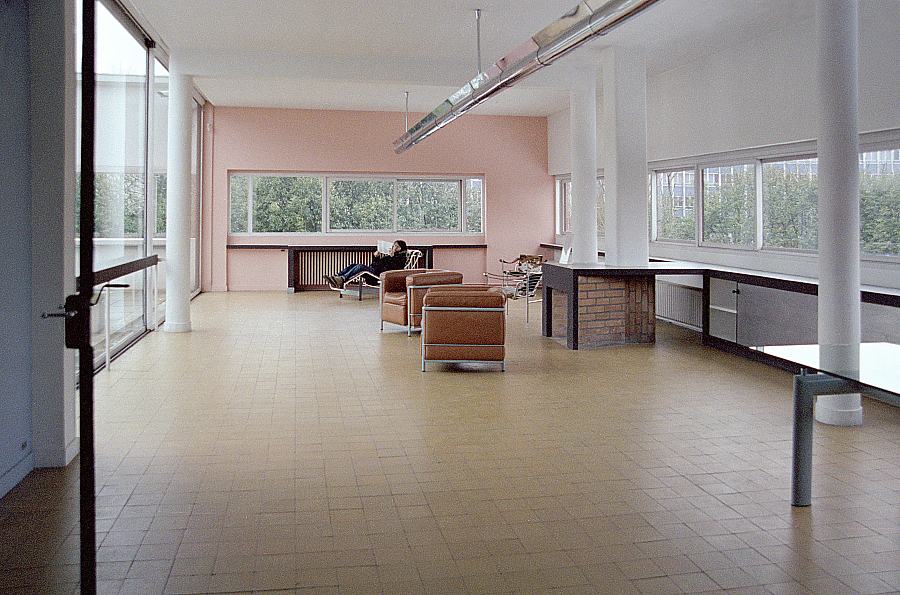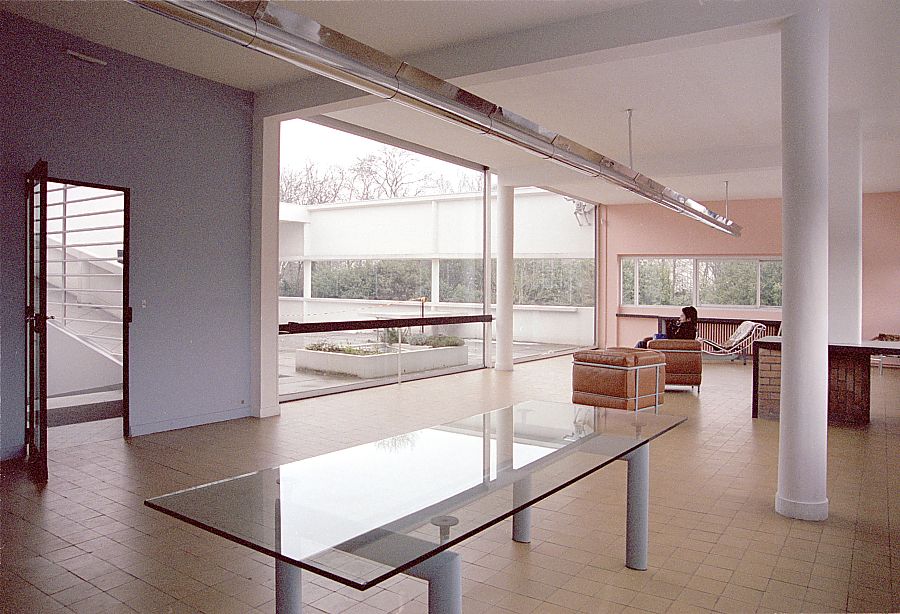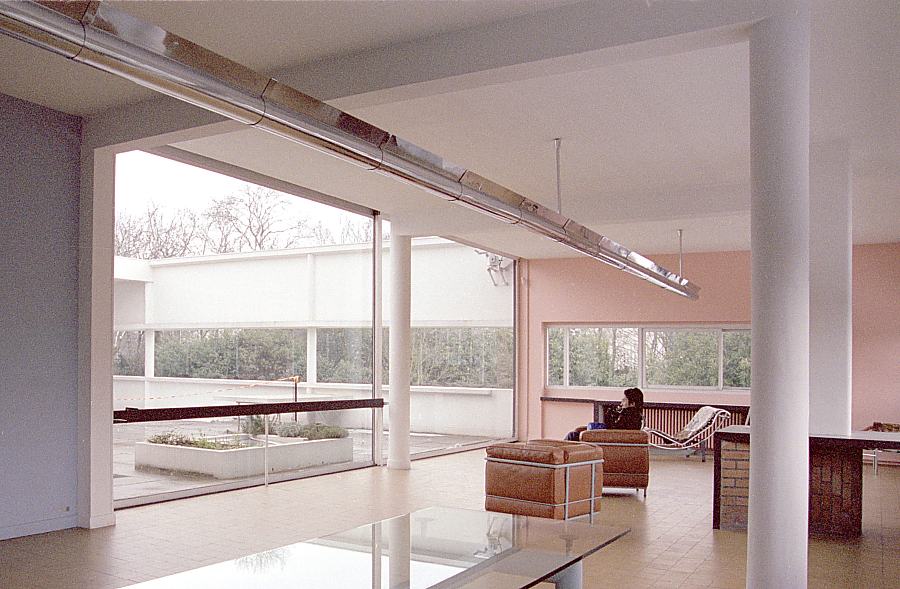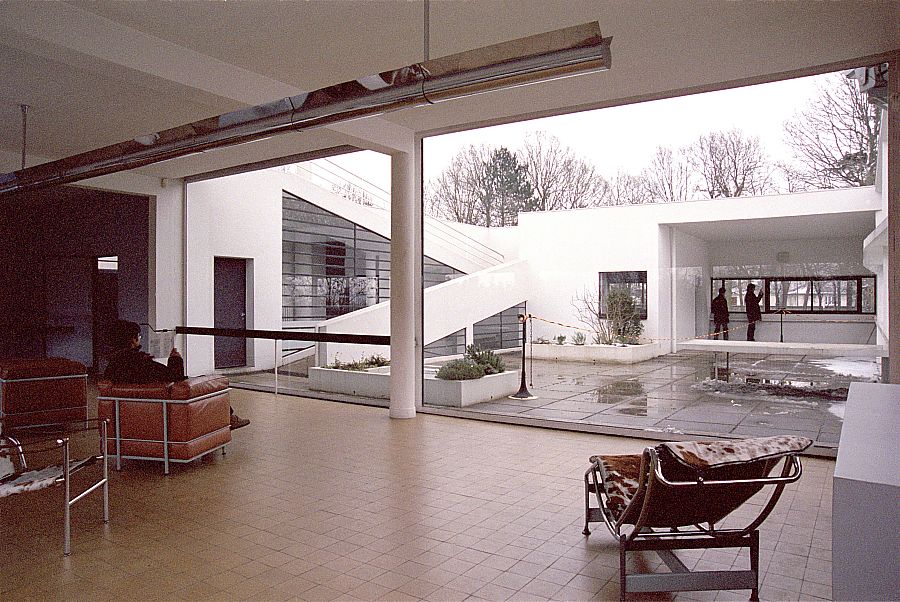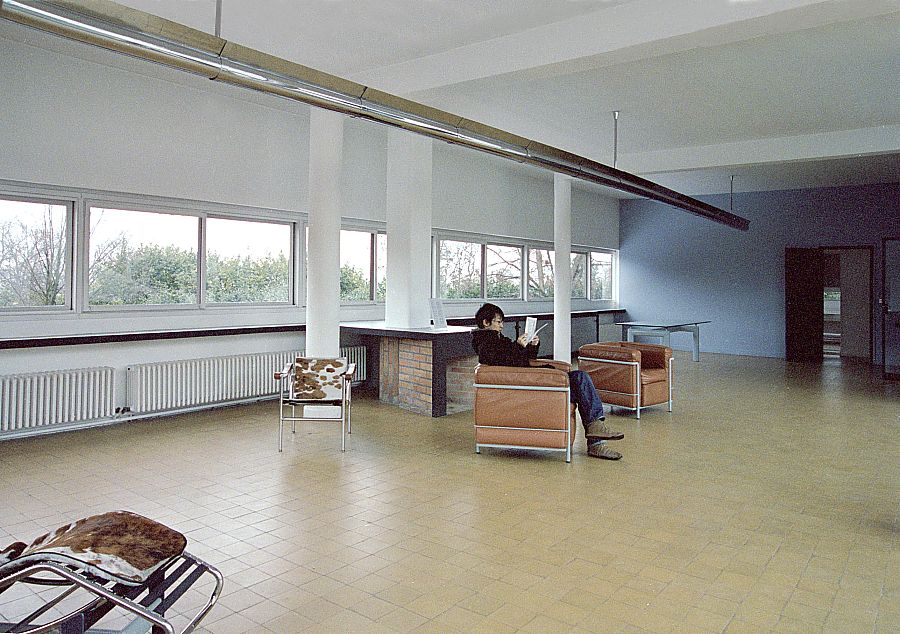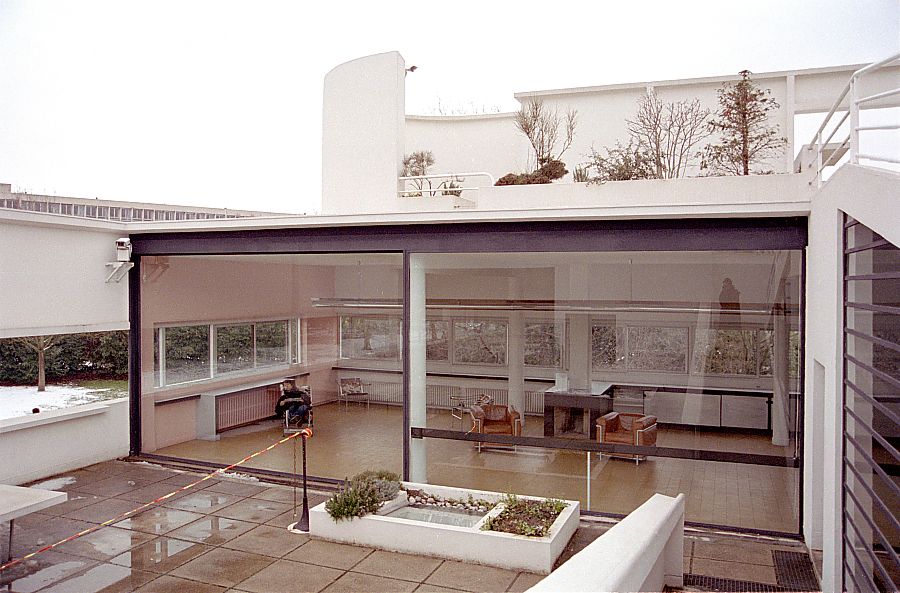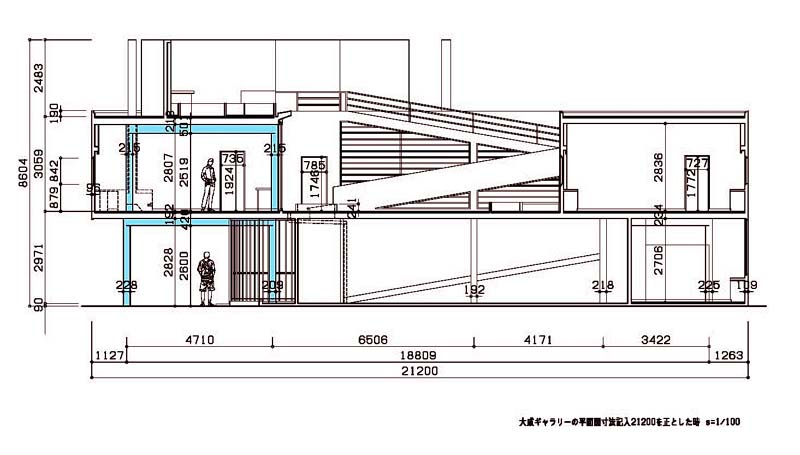Villa Savoye - A watch through photographs
What was the roof garden ?
Designed by Le Corbusier 1931
Photographed by maika
These photographs were taken by NikonFG 24-85 f2.8-4.0 AGFA400. As it was a cloudy day the color tone is pale. Granules have appeared as these were first copied by the film scanner. However, the inside space was photographed in wide perspective using the super wide lens that I was able to take hold of many fresh views.
As a matter of fact, however, we have no pictures of the facade with main entrance, which is the most familiar facade to those concerned in architecture. Since I have no visiting experience, the discovery of this scene missing led me to think about the approaching plan instead. The visitors coming to this villa were to face with the back side of the building first. Not specializing in architecture, the photographer didn't think of getting away from the site and take shot of the north facade. This also taught me about the irregular planning of the composition. The north facade expresses a very important theme of modern architecture, which consists of a rectangular mass (building) lifted by slender pilotis. It expresses a floating envelope and has been appraised as a very important planning. The south facade which is the approaching side from the way in is the exterior of the servant space and expresses the volume of the ground floor. I recognize that the car route curves the entrance and return. Originally I had thought that the sight of north facade, which expressed the theme, was to be held directly as the visitors approached the site from the way in.
Here, I was attracted to a concept that surpassed the noted five principles
of modern architecture. A new relation between inner space and exterior
space= the unity of inside and outside was clearly realized.
Observing this picture I noticed that our eyes would be released from
the view of ceiling plane inside to follow and catch the view of outside
terrace on the roof directly. Why, there are no hanging walls nor a beam
in general to obstruct the view of outside. Although the beams are put
in the direction of going outside , there are no beams put horizontal to
them that would obstruct the view of outside. Moreover, I wonder whether
the ceiling is made of concrete. ( generally the board is used and is ornamental)
Is it possible that the beams in the direction of the eyesight toward outside
were planned to appear but the horizontal parts were put above the ceiling
as T- beam? I was struck to see that such invention had been thought out
already in the early period of concrete structure. The problem we still
face as ones concerned with architecture has been solved directly and simply.
This is to make it open fully toward outside. Contemporary Japanese architects
have been struggling to realize this aim.
However, as I observed the cross section plan, I could not find the
inverted beams. I only found the slabs, 200mm thick. This is an incredible
structure. Suppose we took this kind of plan in Japan, it would be an innovative
measure. I have heard that, in Europe, it is general to build houses in
a structure composed of columns and slabs without the beam.( The idea of
earthquake is totally different)
Let's take a look at the height of each floor. According to the plan,
the measurement is not that high setting. The ceiling height is 2800. 2500
under the beam. The door heights are 1924 or 1746. These are low indeed.
I asked my friend who had been there and her impression of the whole interior
was low height as well.
The huge glass sliding door divides inside and outside. A handle is
provided to open and shut the glass door in warm season. The rails and
window frames are not visible from inside. As this south plane is all glass,
we can see the idea of opening the plane.
As the glass is huge it sees through the abstract exterior space thus producing the unity of inside and outside. It is most incredible to see this kind of huge glass introduced in the early modern period. (height 2.8m and width 4.4m The fixed window lined with the glass door is height 2.8 and width4.6)
The floor is composed that the inside floor extends to outside without
a level difference. ( though the water proof function is concerned. Observing
it closely, drainage runs in the same direction with the fittings.)
Since in this country, the custom is to walk with one's shoes on inside
the
house, the unity of inside and outside may be felt more clearly. The terrace outside is surrounded by walls and the outside looks like the inside. It is an inner yard not visible from the neighborhood. Soil won't come in. The planting of flowers and trees are scarce and the terrace floor is paved. The abstract exterior space has been established here.. On the floor above this, there stands the same kind of exterior space and a penthouse. I imagine that the parties had been held on this innovative and abstractive exterior space with people walking through the slant.
Looking through the pictures, I find large land space left surrounding
this building. The space is not made into a garden (in means of classical
gardens) where people could stroll. However, somewhat I picture to myself
of making the space into a garden to have the visitors stroll and have
the view of the facade.
What does it signify that in spite of the large site, the main theme
would be the garden on the roof ? This may be that the concept focus on
urban houses and not on those provincial villas where the main theme would
be to live close to nature. The garden on the roof may be defined as abstract
nature. It is not the garden filled with the plantings of flowers and trees.
The setting of roof top which is enclosed by walls and is released toward
the sky upward may be similar to the courtyard only lifted one floor up.
It is an enclosed private space which does not collaborate with nature
such as the soil and plants.
I suppose that the client, M. and MME Savoye, might not have appreciated
this setting of spending time at the "private and enclosed "
garden on the roof. I sometimes hear that the villa had been used only
once or twice. In fact, they had lived there until 1940 when they took
the refuge from the Nazis. )(It is written that the building had rain
leaking right after the completion of construction and it was the last
one of the white boxes designed by Le Corbusier.*1)
Of course according to our sense today, it is natural and understandable
to enjoy the private courtyard-like roof garden with unity of interior
and exterior and enjoy fully the nature by going outside.( At least I think
so, though this may not be major.)
This time, these photographs made me think over the concept of Villa
Savoye and in the end I thought that the theme had been to produce enclosed
and private space, the garden on the roof. Until I saw the photographs
this time, my image of Villa Savoye was only a floating rectangular facade.
Of course I knew that there was a garden on the roof and the driveway curved
the building. However, as I took hold of these pictures of the interior
properly taken by super wide lens, I was given a chance to observe the
concept of the interior space created by Le Corbusier.
Unity of inside and outside.
Advanced stage of concrete structure( Domino Style= composed of columns and slabs and no beams)
Abstract exterior space (is opened to Barragan's houses and Ando's Courtyard house in Sumiyoshi)
The interior space in thin skin realized ( It is described in "The Adventure of Contemporary Architecture" by Kenichi Echigoshima. This concept has been pursued by Japanese architects since the latter half of 1970's.)
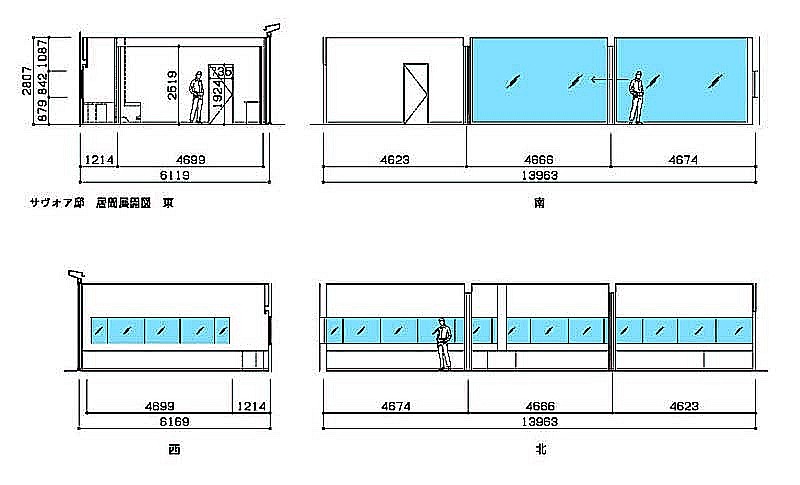
P.S.
This time it was an appreciation of a noted architecture which was
not actually visited but watched through photographs. I hope that you have
enjoyed it. Although in some parts, photographs did not include details
that I wanted to see, the view as a whole has been grasped in a broad aspect.
When we say the garden on the roof, we classify those gardens attached
to the public building and to the private housing.
There is also a difference between the one on the ground floor level of
a courtyard house and that above the second floor or more. Natural gardens
in suburbs with soil and plantings and urban abstract gardens that are
paved.
The abstract garden on the roof which is the exterior space is opened to the abstract space in Cubism architecture.
The attempt to signify these differences. These attempts may follow
the continuation up to today.
I sincerely wish that the locals in France would open the photographic website like the one we pursue (More Data Photograph Corner).
050413
( Cross plan taken from one of the noted collection of photographs,
had been traced by CAD. Each measurement was filled in by figuring it out
according to the length of the building, 21200, which was inscribed in
the plan exhibited at Taisei Gallery. Accordingly, it is the estimated
measurement and provided for reference. Since measurement means greatly
for those in architectural practice, I figured it out for reference. It
is regretful that we cannot easily take hold of the plan with these simple
measurements written in for this gem of architecture.)
What did the roof garden of Villa Savoye signify ?
Looking through these pictures I realized that the roof garden of Villa
Savoye had come out innovating the meaning of roof gardens already established
in the collective houses such as those by Antoni Gaudi and Le Corbusier's
other project, Unite d'Habitation. This garden was conceived as the courtyard
that secured privacy. It was lifted to second floor, enclosed by the exterior
walls of one floor height and had been paved without soils. This can be
said to signify the beginning of abstract exterior space where the more
it leaves the earth the more privacy would be acquired. In terms of the
style of design it can be described as the expression of exterior space
in Cubism and abstract design. I find that from here starts the development
of exterior space taking leap from nature.
The value of this beginning would be estimated only after observing
the accomplishment seen today, because the phrase, the beginning of abstract
exterior space, is only the expression written out. The Villa Savoye in
its actual appearance is filled with many elements : slant, small planting,
opened space in the surrounding wall, variety of enclosure. The abstract
garden here is not yet simple. Starting from this point, we must see how
it would appear when the garden on the roof would be simplified as an urban
house and a private space.
The answer to this question can be found in the abstract outer space
of Courthouse in Sumiyoshi(1976). Although Ando says that, in this construction,
he tried to conserve nature as we are losing nature nowadays, there are
no plantings here. The elements of nature are the sun, the wind and the
rain only. Only the air outside is the nature here. This might be called
the abstract nature.
I also find the abstract nature in the courtyard designed by Luis Barragan.
The plantings planted in Barragan's courtyard have been restricted and
we observe a symbolic tree. The surrounding wall and the primary colors
express abstraction.
If I might go on further, I must to refer to "Villa in the Wood"
by Kazuyo Sejima (1994). This was the first work that I recognized the
progressive realization of abstract garden. The studio which is in the
center of this villa is almost outside , by Sejima's definition, but is
the interior. Why, we can see the abstract private courtyard here. This
is the outside paved in white tiles and it is suited to walking barefoot.
There may be other works appropriate to express this concept, however,
please excuse my ignorance and let me refer to this work as an example.
In the Villa Savoye, although it was constructed as a private residence,
the public space (guest rooms) as provided as well to welcome guests. However,
as the history of modern family tells that nowadays the family tends to
be what is called "a nuclear family", the space for social occasions
(such as ceremonial occasions) has been transferred to outside the residential
space. This implies that the residence has become simplified as a private
place.
In this aspect, the roof garden brought up from the ground by the pilotis
signifying the concepts such as uniting inside and outside and securing
abstract exterior can be concluded to signify, in terms of the plan for
housing, the concept to secure privacy of the family relation. In the end
it seems to express privacy, which is the simplification of the internal
aspect of the family.
050414
参考hp
JDN西海岸もの+がたり
ギャラリー大成
ギャラリー大成テキスト
ル・コルビュジエフリー百科事典
愛と哀しみのル・コルビュジエ 市川智子
コルヴィジェの横長の窓
ーーーーーーーーーーーーーーーーーーーーーーーーーーーーーーーーーーーーーー
As my other friend has given me a new information, I would like to
mention the domino system of Le Corbusier.
It is available at Villa Jeanneret where Le Corbusier Foundation is
located. It introduces the Pessac houses. I found a famous perspective
of domino housing and the cross plan in detail.
According to the perspective, the domino housing consisted of columns
and slabs and without beams. However, according to the cross plan in detail,
one could observe beams which were incredibly in low height in Japanese
standard. As I observed the cross plan further, I found that it was composed
of boards in shape of rectangular tubes affixed between the beams. This
way it looked as though there were no beams and thus the flat slab plane
had been produced. The wall plan to divide rooms would not be restricted
by beams. It would be convenient to build the small houses with many divisions.
It may be the process considered in the days when there was no idea yet
of an ornamental ceiling.
The inside space which flows to outside would be created by this kind
of flat slab ceiling composing architectural beauty. Here, the notable
point may be that the ceiling is plastered in the same way as the wall,
thus producing the unity of space. However, in Japanese system, the beams
are usually more thick and various equipments are fixed on the ceiling
planes. This kind of unity of space can not be produced easily. (Although
in Japan, the plaster ceiling had been put in wooden houses constructed
after the war.)
050505 mirutake
My friend who lent me this pamphlet had once been hired in one of the
architectural firms in Europe and he showed me another instruction manual.
He remembered that he had also coped with the process similar to the one
in domino housing. It is the construction to place reinforced concrete
slab about 4cm thick and underneath, carry across the casting of cavity
brick in the span. This kind of construction is not done anymore, but it
remains as an example which had been done in the past.












